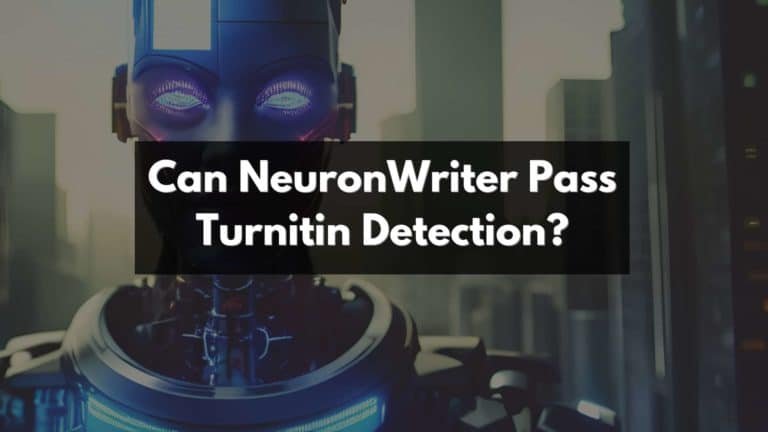Can Texta Pass Originality.ai Detection?
Ever wondered if Texta can slip past the eagle eyes of Originality.ai‘s detection? You’re not alone! Like you, I’ve found myself questioning the stealthiness of this AI tool. The surprising result from my deep-dive research: Originality.ai flaunts an impressive average accuracy rate of 99.41% in detecting text generated by GPT-4, GPT-3, GPT-3.5, and ChatGPT! This article unravels Texta’s success or failure to dodge this highly accurate AI detector and offers tips for producing content that doesn’t ring alarm bells.
Ready for a game-changing read?.
Key Takeaways
- Originality.ai boasts an impressive average accuracy rate of 99.41% in detecting text generated by AI models like GPT-4, GPT-3, GPT-3.5, and ChatGPT.
- Using Texta may not be the best option for passing AI detection as Originality.ai can accurately identify it with a 94% accuracy rate.
- To avoid detection by AI content detectors, writers should not solely rely on AI – generated content and instead incorporate their own unique perspective and revise the text without changing its core meaning using tools like QuillBot.
- Other tips for avoiding detection include avoiding repetition in writing, adding a personal touch to make the content more authentic, rewriting the text to give it a human-written feel, and self-checking work before submission.
Overview of AI Content Detection
AI-detection tools are programs designed to identify and flag AI-generated content by analyzing various aspects of the text, such as writing style, vocabulary usage, and context. These tools use machine learning algorithms to compare the input text with a database of known AI-generated content in order to determine its authenticity.
What are AI-Detection Tools?
AI-Detection tools are revolutionary software programs that identify if a piece of writing is AI-generated or human-written. They utilize artificial intelligence algorithms to analyze text for patterns and distinctive features commonly found in content produced by AI.
Popular examples of these tools include Originality.ai, which boasts an impressive accuracy rate in distinguishing between human and machine-produced content. Creating immense value for maintaining academic integrity to prevent plagiarism, they can also detect potential copyright infringements.
These innovative software applications have emerged as indispensable resources in today’s ever-evolving digital landscape where legitimacy and authenticity are paramount.
How Accurate are AI Detectors?
AI detectors have made significant advancements in accurately identifying AI-generated text. Tools like Originality.ai boast an average accuracy rate of 99.41% in detecting text created by powerful models such as GPT-4, GPT-3, GPT-3.5, and ChatGPT.
These detectors can consistently recognize content generated by AI and differentiate it from human-written text with high precision. It is crucial for those seeking an AI content writer to be aware that relying solely on AI-generated content can have negative consequences when it comes to passing AI detection systems.
Can Originality.AI Detect Texta?
Originality.AI is a powerful tool designed to detect AI-generated text, and it does have the capability to detect Texta. With an impressive accuracy rate of 94%, Originality.AI can accurately identify AI-generated content from sources like GPT-3, GPT-3.5, and ChatGPT.
This means that if you’re looking for an AI content writer who can pass AI detection, using Texta may not be your best option. It’s crucial to use original human-written content or revise AI-generated text with tools like QuillBot to avoid detection and ensure authenticity in your work.
Tips to Avoid Detection
To avoid detection, don’t solely rely on AI-generated content, avoid repetition, add a personal touch, rewrite your content, and self-check your work.
Don’t rely solely on AI-generated content
AI-generated content can be incredibly useful, but it’s important not to rely solely on it. While AI tools like GPT-4, GPT-3, and ChatGPT have advanced capabilities, they are still detectable by AI content detectors like Originality.ai with a high level of accuracy.
By depending solely on AI-generated content, you run the risk of being flagged for plagiarism or copyright infringement. To ensure your content is authentic and passes AI detection, it’s crucial to incorporate your own unique perspective and revise the text without changing its fundamental meaning using tools like QuillBot.
So remember, while AI can be a valuable tool in content creation, it should not be the sole source of your work if you want to avoid detection.
Avoid repetition
To avoid detection by AI content detectors, it is crucial to avoid repetition in your writing. Using the same phrases or ideas multiple times can make it easier for AI recognition tools to identify your text as AI-generated.
When crafting your content, be mindful of using synonyms and varied language to express your thoughts. By introducing fresh perspectives and alternative ways of conveying information, you can add depth and uniqueness to your writing while reducing the likelihood of being flagged as AI-generated text.
Repetition not only makes your writing seem less authentic but also increases the risk of getting caught by AI detection systems. By consciously avoiding repetitive patterns, you can enhance the originality and authenticity of your content.
Add a personal touch
I always make sure to add a personal touch to my AI-generated content. By injecting my own unique perspective and experiences into the writing, I can make it more authentic and less likely to be detected by AI content detectors.
This personal touch not only makes the text more engaging for readers but also helps to hide any traces of artificial intelligence. So, whether it’s through storytelling, anecdotes, or sharing personal insights, adding that human element can go a long way in creating content that passes AI detection with flying colors.
Rewrite your content
To increase the chances of your content passing AI detection, it is recommended to rewrite the text. This involves using tools like QuillBot to revise the AI-generated content without changing its core meaning.
By putting a personal touch on the text and making it more human-written, you can reduce the likelihood of being flagged by AI content detectors. Taking this extra step can help you achieve better results in terms of passing AI detection with your written work.
Self-check your work
I always make sure to self-check my work before submitting it. This is especially important when it comes to AI-generated content and avoiding detection. By reviewing my writing thoroughly, I can identify any repetitive phrases or patterns that might trigger AI detectors.
Additionally, self-checking allows me to add a personal touch and revise the text without changing its fundamental meaning. Taking these steps ensures that my content remains authentic and avoids being flagged as AI-generated.
So, don’t forget to self-check your work too!
False Positives and Limitations of AI Detection
AI detectors may sometimes produce false positives, leading to the identification of original content as plagiarized. However, it is crucial to understand the limitations of AI detection technology and how these tools should be used appropriately to ensure accurate results.
False positives in AI content detection
AI content detection algorithms are designed to accurately identify AI-generated text, but they are not without their limitations. One of these limitations is the occurrence of false positives, where genuine human-written content is mistakenly flagged as AI-generated.
This can be frustrating for writers who are trying to create original content that passes AI detection. While AI detectors have high accuracy rates, there is still room for improvement in minimizing false positives and ensuring that human-written text is correctly identified.
So, it’s important for both writers and AI detection tools to continue refining their approaches to achieve more accurate results and avoid unnecessary false alarms.
In addition to false positives, there are other factors that influence the effectiveness of AI content detection technology. These include the complexities of different language styles and variations in writing patterns across individuals.
How should AI detectors be used?
AI detectors should be used as a valuable tool for verifying the authenticity and originality of content. By utilizing AI detection technology, content creators can ensure that their work is not flagged as AI-generated, which could lead to negative consequences.
However, it is important to remember that these tools have limitations and may produce false positives. Therefore, it is essential to use them alongside other techniques like self-checking your work and adding a personal touch to avoid detection.
Ultimately, AI detectors should be seen as aids rather than definitive judges of content authenticity.
Are AI detectors easy to trick?
AI detectors are not easy to trick. They are designed to accurately identify AI-generated text and can detect various AI models like GPT-4, GPT-3, GPT-3.5, and ChatGPT with high accuracy rates of up to 99.41%.
Tools like Originality.ai have been specifically developed to detect AI content and have shown an accuracy rate of 94% when identifying texts generated by popular AI models. While some sites claiming to catch AI-written text may fail in their detection accuracy, it is generally challenging to deceive AI detectors effectively.
Therefore, if you’re looking for an AI content writer who can pass AI detection, it’s crucial to exercise caution and ensure the authenticity of the content you use.
What is and isn’t a false positive?
A false positive in AI content detection occurs when the tool mistakenly identifies human-written text as AI-generated. On the other hand, a true positive is when the detection accurately flags AI-generated content.
It’s important to note that false positives can happen due to various factors, such as similarities between human and AI writing styles or limitations in the detection technology. Detecting false positives helps ensure accuracy in identifying original and authentic content while avoiding unnecessary penalties or consequences associated with plagiarism or copyright infringement.
Limitations of AI detection technology
AI detection technology, while impressive in its accuracy, does have certain limitations. One such limitation is that AI detectors may sometimes produce false positives, mistakenly flagging human-written content as AI-generated.
This can be frustrating for writers who are trying to create original content but find themselves being flagged by these tools. Additionally, AI detectors may not always be foolproof when it comes to detecting sophisticated AI text generation models like GPT-3 and ChatGPT.
As a result, there is still room for improvement in the realm of AI detection technology to ensure more accurate and reliable results.
Another limitation worth noting is that some sites claiming to catch AI-written text may fall short in their detection accuracy. While tools like Originality.ai boast high accuracy rates for detecting specific models of AI-generated text, it’s important to remember that no tool is infallible.
Therefore, relying solely on an AI detection tool’s verdict might not be enough to guarantee complete authenticity or avoid potential consequences associated with using easily detectable AI-generated content.
In conclusion, while advancements in AI detection technology have made significant strides in identifying and differentiating between human-written and AI-generated content, there are still limitations that need to be addressed for more accurate outcomes.
With ongoing improvements and further research into this field, we can hope for even better solutions to ensure the integrity of written content in the digital age.
Conclusion
In conclusion, while AI content detectors like Originality.ai have a high accuracy rate in detecting AI-generated text, there are ways to avoid detection. Writers can follow tips such as adding a personal touch, avoiding repetition, and rewriting their content.
However, it is important to remember that AI detection technology is constantly improving, so it’s best to prioritize originality and ethical writing practices.
FAQs
1. Can Texta pass Originality.ai detection?
Texta is a AI language model developed by OpenAI and it does not have the ability to pass or fail any specific detection tool like Originality.ai. The results of plagiarism detection would depend on the algorithms and criteria used by each individual platform or software.
2. How effective is Originality.ai in detecting plagiarism?
The effectiveness of Originality.ai in detecting plagiarism can vary depending on the specific algorithm and dataset used by the tool. It is important to note that no plagiarism detection software is 100% foolproof, as there are always potential limitations and challenges in identifying all instances of plagiarized content.
3. Are there any other reliable plagiarism detection tools available besides Originality.ai?
Yes, there are several reliable plagiarism detection tools available in addition to Originality.ai. Some popular options include Turnitin, Grammarly, Copyscape, and Plagscan. Each tool may have its own strengths and weaknesses, so it’s recommended to compare features and user reviews before deciding which one suits your needs best.
4. What should I do if my text fails the originality check using a tool like Originality.ai?
If your text fails an originality check using a tool like Originality.ai or any other similar platform, you should carefully review the flagged content for possible instances of unintentional or accidental similarities with other sources. You may need to revise or rewrite sections that are identified as potentially copied or plagiarized in order to ensure ethical writing practices and avoid potential consequences such as academic penalties or copyright infringement claims.





